These are strange times. While medical professionals are striving to maintain COVID-19, businesses around the world are struggling with the disruption of the day-to-day.
It’s a confusing time for everyone. Many of us don’t know what the next steps are.
That’s why Leadfeeder’s CMO, Andy Culligan, and our friends Marc Chabot, CEO of Reachdesk, and Alex Olley, Co-Founder of Reachdesk, hosted a webinar on Thursday, March 19 on how to keep calm and create a pipeline during the coronavirus outbreak.
In this webinar, both teams shared strategies that commercial teams can use to build a pipeline of high-intent online leads now during a time of crisis.
This is a new world for us. And we all need to find new ways to better our marketing and sales efforts.
Here’s a recap of the webinar presentation.
Impact of COVID-19 on B2B Events
Life, in general, has changed.
Here’s a look at St. Patrick’s Day in 2019 outside of Temple Bar in the center of Dublin.

And, here’s a look at that same location in 2020.

Events and public gatherings of all kinds have been put on hold as we move into this new normal.
And B2B events are going to see the impact over the coming months.
Let me show you how.
This 2019 Events Marketing Benchmarks & Trends report interviewed 1K+ senior marketers at companies managing over $738 million in event spend per annum from the software, services, and media industries.
Here are a few highlights from that report that stood out to us:
30% organize events to support lead generation + sales acceleration
41% see live events as the most critical marketing channel in achieving business outcomes
63% plan to increase their budget by 22% in 2020
As you can see, events play a significant role in marketers and sales teams' lives. Many businesses depend on events to generate sales.
We look to February, March, April, and May as the peak of the season. Then, again later in the year.
These are pivotal times to start creating a pipeline.
Based on the current landscape of the world, the biggest events of the year have been canceled.

SaaStock has been postponed to 2021.

Adobe’s Digital Summit moved to online.

And, the list goes on.
“When we come out of this, we all believe we’ll come out as better salespeople and better marketers because we’re just going to have to improve in how we do things.” — Andy Culligan, CMO of Leadfeeder
Our CMO, Andy Culligan, spoke to a company that went to DMEXCO last year in 2019.
That company spends $30k EUR to send four salespeople to manage 50 pre-booked meetings. They managed to capture 100 leads that drove $500K EUR in their pipeline.
That’s a pretty massive pipeline to lose. So, how do we fill in that gap?
Let me show you how.
Here’s what outreach looked like pre-2020
Does this look familiar?

If you’re an SDR or worked as an SDR, you know this story.
It’s all about making as many calls and sending as emails as possible.
It’s a numbers game. And, let’s be honest, has it really moved away from that?
Andy receives at least 5-6 sales outreach emails a day from SDRs.
Let’s walk through a real-life example of the current outreach emails from salespeople.
Touchpoint 1

Good things:
Data-driven marketer stroked the ego a bit.
Plus, promising to convert more sites.
So, let’s say you give him the benefit of the doubt and connect.
Here’s Andy’s response.

Things an SDR should consider:
Andy has already been using a competitor product.
Most likely, he’s already spent a lot of time integrating it into his tech stack.
And, here’s the next message from the SDR.

The customer automatically assumes that whatever they have to offer is not of value because of the 50% cost.
Andy clarifies, “If you drop your price by 50%, you’re not selling me on the value of your product. You’re selling me on the value of a price.”
You can’t put a price on the number of hours spent integrating this product into your tech stack.
Andy replies.

The moral of the story is that when you reach out now, you need to have the following:
A good message
Understand the current position someone is in. Learn what type of data is available before you reach out, which competitor I’m using, use the tools that are available, etc.
So, why do we all still receive outreach like this?
Because most SDRs are driven by lists.
The numbers game is challenging. You have to hit a certain number of calls, emails, connections, etc. per day.
That takes away the time the SDR needed to do additional research; the message would be personalized better.
Then, it’s about chasing the meeting.
In the outreach examples above, the number one thing that was of interest to that SDR was closing the deal.
Today, you don’t chase to close the deal.
You chase to ask them how they are doing.
So, how could this SDR from the examples above have made his life a little easier?
That’s where Leadfeeder comes into play. Leadfeeder can help SDRs prioritize, research, and personalize based on behavior intent data.
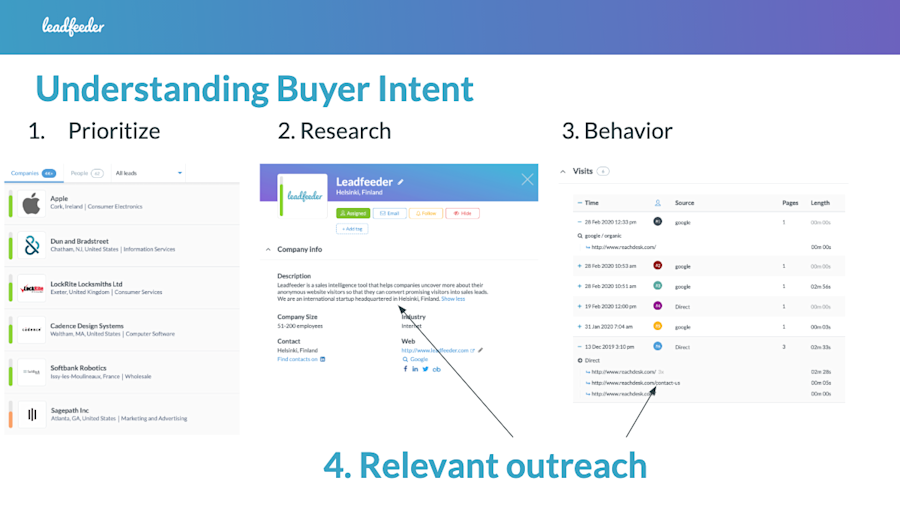
So, to be top of mind, SDRs can see the companies that are already visiting their website.
Dive into the data to answer questions like:
Have they looked at our pricing page? Webinars? Blog post?
Where are they located?
How many employees do they have?
Which channels they’ve been visiting from?
Leadfeeder provides this buyer intent data to help SDRs tailor their outreach based on interests.
“Leadfeeder helps SDRs personalize based on what someone’s interests are rather than going in completely cold.” — Andy Culligan, CMO of Leadfeeder
This isn’t anything new.
But, it’s important now than ever now to take those buyer intent signals based on first-party data to create relevant outreach to those companies that have already been interacting with your website.
2020 is the year of digital empathy
Events and outreach can’t be face-to-face right now. Digital is more vital than ever.
That’s why this is the year of digital empathy.
Digital empathy is typically put together based on digital products and how those products are made.
However, marketers and sales teams need to look at this a bit differently in today’s world.
Your outreach needs to have empathy.
Your brand needs to present itself with empathy.
Let’s start at the beginning.
What is the actual meaning of the word empathy?
empathy
the ability to understand and share the feelings of another.
Our CMO, Andy, stresses to his SDR teams that even when you’re picking up the phone, remember someone is going to be on the other end.
The critical word is “someone.” It’s a person. No one wants to feel like a number.
Raise your hand if you’ve felt like a number the last time an SDR reached out to. 🙋♀️
My guess is most of you. You know you’re on a list. And, you know you’re just another deal to be closed.
There’s no feeling for making a connection.
Nowadays, we need to have more empathy.
Harvard Graduate School of Education shared these tips for sales leaders on teaching each other empathy.
Demonstrate empathy for others, including those different from you.
Engage in self-care and self-reflection.
Keep to a clear message.
Help your children understand that the world doesn't revolve around them.
Discuss ethical dilemmas.
As times are changing, message and the product needs to solve a problem. And, it’s up to the marketers and sales teams to discover how to do that in an empathetic way.
Now is the time for testing. What is working? How to replicate it?
This is the new normal. So, we, as marketers and salespeople, need to create a new playbook.
Below are a few ideas to put this into action.
9 strategies to add to your marketing & sales playbook in today’s new normal
It’s time to change the playbook. We have to change the conversation.
Marc Chabot, CEO of Reachdesk, says:
“That playbook you used to have, it’s not going to work anymore. This is an opportunity for sales and marketing to think about how they want to do something in a new way.”
Companies need to be true to your brand. No one wants to be converted today in the world.
For example, if you’re pushing CTAs in your marketing campaigns, you’re turning people off.
No one wants to be converted today in the world.
If you’ve got paywalls or gated content, marketers and sales teams need to fight the battles in your organization to change that because people don’t have time.
If someone fills in the gated content form today, they know they are going to be sold to tomorrow.
No one wants to be sold to today.
As sales and marketing professionals, we need to be brave and change the conversation inside our own companies.
Do more of what worked yesterday. The reality is that’s not going to work.
“We’ve got to start with communicating to our customers and our prospects that you as a brand care.” — Marc Chabot, CEO of Reachdesk
Marc continues to share his advice to send an email to ask them how they are doing along with an Uber Eats voucher.
That’s a powerful message today.
Your goal is to communicate that your brand is there. You’re trying to help. You’re happy to educate.
But, most importantly, you don’t want anything in return.
Marc emphasizes, “You will reinforce your brand, your conversation, your opportunity with prospects. I guarantee they will respond positively.“
Asking your prospects to make a decision today may not be possible in their environment. It may be challenging to figure out how to even start that conversation.
Marc proceeds to share an inspiring message for all marketers and salespeople.
“The opportunity you have is to be there for your prospects. And, when they are ready, prospects will come to you if they trust you.” — Marc Chabot, CEO of Reachdesk
These times will be defined by the people that take action.
Prospects can learn to trust you.
It starts with marketing and sales. It begins with serving your customers. It starts with doubling-down to deliver value and asking for nothing.
Strategy 1: Step into their shoes
Alex Olley, Co-Founder of Reachdesk, started by looking at real intent data in Leadfeeder to understand what his prospects were doing, what they are searching for, and how he can tie it all together.
You’re able to review visitor behavior at every stage of your sales funnel.
For example, if I know a user is coming to my website and searching for handwritten notes on Reachdesk, I can go back to them with a value-led message based on their activity.
All of this is based on intent data within Leadfeeder.
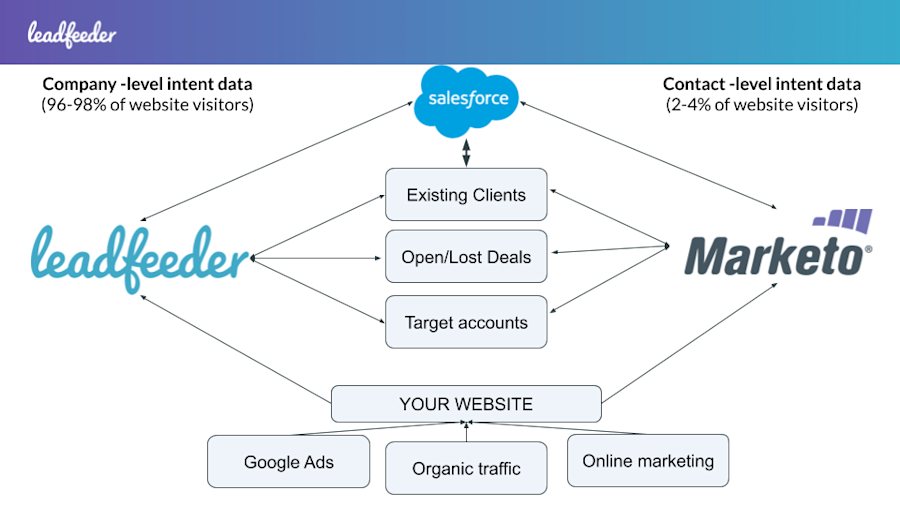
Strategy 2: Get personal
Alex got on a call with a prospect wearing a hat while working from home. So, Alex put on a hat with him.
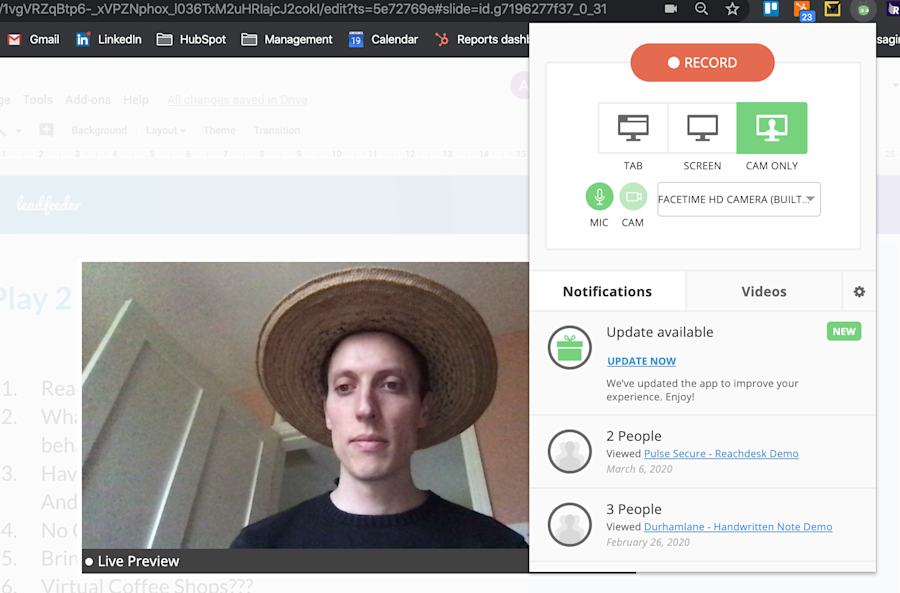
In the past, no one would have been wearing a hat in an office setting. But, now, it’s okay to get more personal.
Most people are in their homes. People are starting to think differently about how they behave at home. And, marketers and salespeople should too.
Alex says:
“Take the playbook. Throw it out the window. Be personal. But, ultimately, make it about the prospect.”
Bring value to the table in a personalized way.
Alex took this a step further with his SDR team by telling them to stop booking meetings. Start speaking with people.
The best part?
His SDR team started booking more meetings.
Strategy 3: Make online events engaging
We know events are canceled, but if you’re going to take them online, you need to start making them engaging.
Start with the small things like buying someone lunch, coffee, cupcake, anything to make their day better.
Think about gamification with tools like Kahoot to get prospects or your team to engage virtually.
For example, Alex asked his team to share something unique about each of them, then the rest of the team had to guess who belonged to each trait.
Another fun idea is to start a virtual coffee shop. If people show up, give them a free coffee gift card.
While there’s no ask right now, you can start tracking this data so you can engage with them in the future.
Strategy 4: Surprise someone
We’ve all got things going on in our lives right now. Our personal lives still continue while people adapt to working from home.
Find a way to make a difference in their personal life. Think about a way to make them feel better. And, make it shareable.
A small gesture of sending a prospect a coloring book for their kids at home could create a memorable experience that they will never forget.
Just remember — don’t ask for anything in return. You can continue to track the data for future use and still build a trusting relationship.
Here’s an example of how Reachdesk is thinking outside of the box.
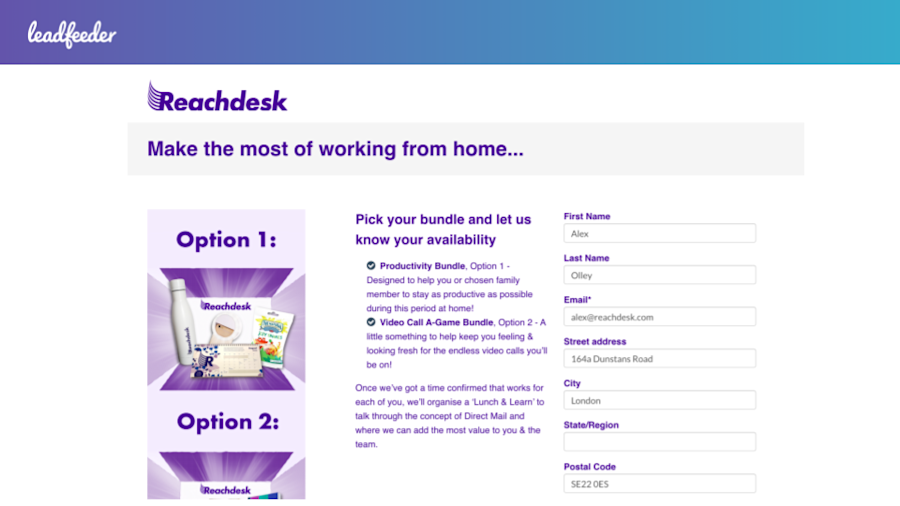
Reachdesk is creating a personalized outreach email with a link to this page, letting their customers know they are thinking about them and that they care.
Strategy 5: Give someone your time
We’re all stuck isolated right now with very little human interaction. Kids are screaming. Dogs are barking. Your back hurts because you don’t have an office chair.
You want to find a way to relate to people right now.
Pick up the phone to just ask, “Hey, how are you doing? How are you coping?” can go a long way.
No agenda. Simply two people are chatting.
Alex from Reachdesk has talked to 30 CEOs this week already. As a result, they might buy Reachdesk in the future, or Alex might purchase something from them.
Right, it’s about building a sense of global community.
Strategy 6: Start a referral strategy
Another option is to start a word-of-mouth referral program. You have a customer base that most likely appeals to one another. So, make an introduction.
Think about your network. There may be options to cross-pollinate other businesses.
Strategy 7: Reschedule
A lot of us had events planned. And, the majority of those events are canceled.
As an SDR, when you see a cancellation of a potential prospects demo, it can feel like a gut-check.
When this happens, explain to the prospect why you wanted to continue. Tell them what you were going to talk about.
Show them how you still add value.
Reconfirm why it’s essential to their success in the future.
You can also send a little thank you for taking the demo.
For example, at Reachdesk, everyone who takes a demo receives a Starbucks gift card.
Reachdesk doesn’t expect anything in return. The prospect has already given them enough time.
But, you can use that to start a positive conversation.
Strategy 8: Do something good for the world
While you may not be able to provide a gift card now, you can find ways to give back to your community.
Yotpo’s Account Executive, Tom Clarke, shared this post on social media.
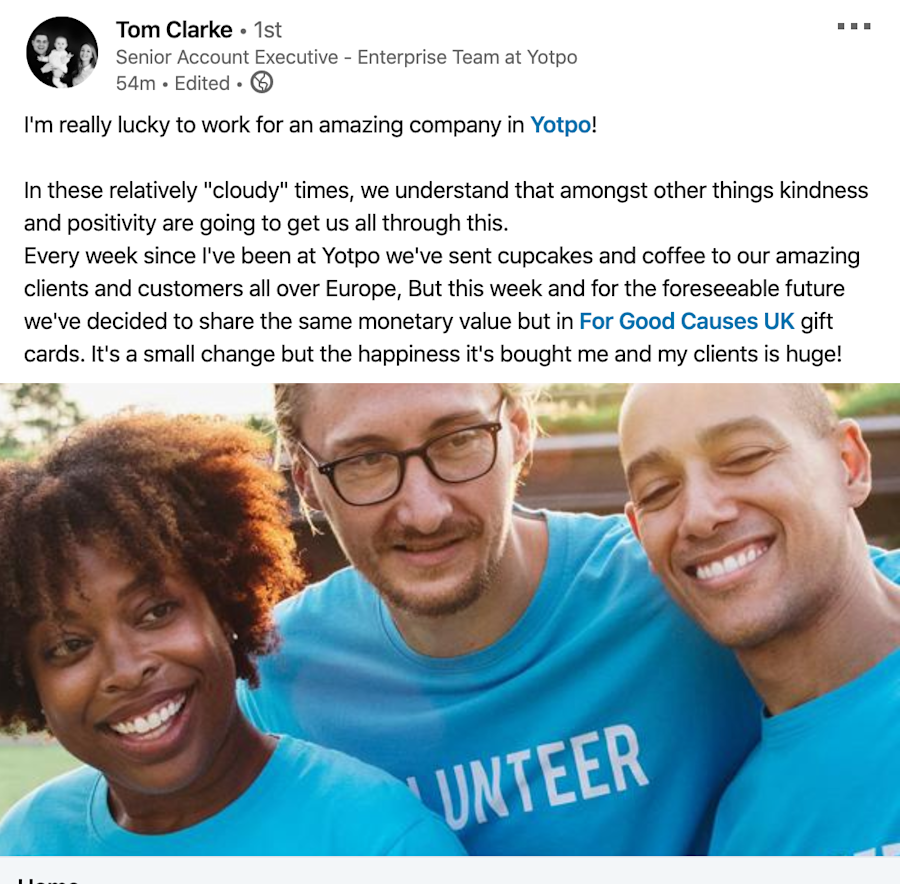
In the past, Yotpo does ABM bundles with cupcakes, gifts, etc. to help nurture their sales cycle.
Yotpo stopped.
Instead, Yotpo is donating all of that money value to a charity.
Nothing about prospecting. It’s about doing good for the world.
Strategy 9: Don’t forget your customers
Your existing customer base is the most important thing.
If you have a product, you want your customers to get better at using it. So, now is a time to educate your customers.
Start by sending them a Vidyard video just to say, “Hey! It’s Alex. I’m thinking about you right now. How is everything going?”
Now is the time to plan for normality
We’re all feeling it. But this isn’t the first time.
In 2009, companies like Airbnb, Slack, Uber, and Stripe were able to weather the storm and come out on top.
Follow their lead by teeing yourself up for the future. You want to be the first thing a prospect thinks about when they are ready to buy.
Kindness and understanding will go a long way in your marketing and sales efforts.
Demonstrate that you care. Don’t ask for anything back—complete empathy.
The world will go back to normal. And the marketing and sales teams will be there.
In case you missed it, you can watch the webinar on our YouTube channel.
Now that you're here
Leadfeeder is a tool that shows you companies that visit your website. Leadfeeder generates new leads, offers insight on your customers and can help you increase your marketing ROI.
If you liked this blog post, you'll probably love Leadfeeder, too.
Sign up







